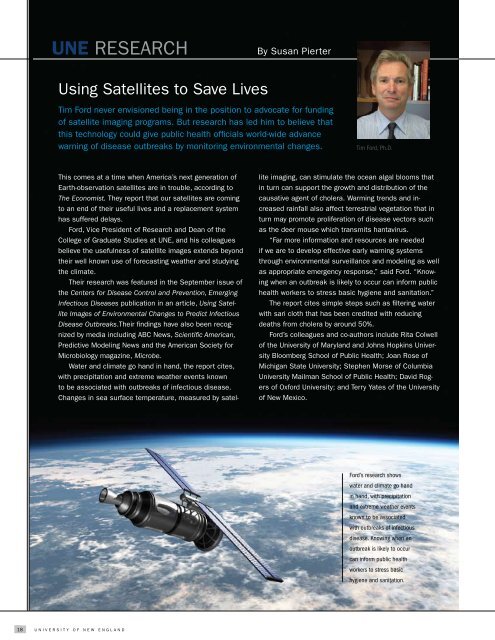University of New England
University of New England
University of New England
You also want an ePaper? Increase the reach of your titles
YUMPU automatically turns print PDFs into web optimized ePapers that Google loves.
UNE RESEARCH<br />
By Susan Pierter<br />
Using Satellites to Save Lives<br />
Tim Ford never envisioned being in the position to advocate for funding<br />
<strong>of</strong> satellite imaging programs. But research has led him to believe that<br />
this technology could give public health <strong>of</strong>ficials world-wide advance<br />
warning <strong>of</strong> disease outbreaks by monitoring environmental changes.<br />
Tim Ford, Ph.D.<br />
This comes at a time when America’s next generation <strong>of</strong><br />
Earth-observation satellites are in trouble, according to<br />
The Economist. They report that our satellites are coming<br />
to an end <strong>of</strong> their useful lives and a replacement system<br />
has suffered delays.<br />
Ford, Vice President <strong>of</strong> Research and Dean <strong>of</strong> the<br />
College <strong>of</strong> Graduate Studies at UNE, and his colleagues<br />
believe the usefulness <strong>of</strong> satellite images extends beyond<br />
their well known use <strong>of</strong> forecasting weather and studying<br />
the climate.<br />
Their research was featured in the September issue <strong>of</strong><br />
the Centers for Disease Control and Prevention, Emerging<br />
Infectious Diseases publication in an article, Using Satellite<br />
Images <strong>of</strong> Environmental Changes to Predict Infectious<br />
Disease Outbreaks.Their findings have also been recognized<br />
by media including ABC <strong>New</strong>s, Scientific American,<br />
Predictive Modeling <strong>New</strong>s and the American Society for<br />
Microbiology magazine, Microbe.<br />
Water and climate go hand in hand, the report cites,<br />
with precipitation and extreme weather events known<br />
to be associated with outbreaks <strong>of</strong> infectious disease.<br />
Changes in sea surface temperature, measured by satellite<br />
imaging, can stimulate the ocean algal blooms that<br />
in turn can support the growth and distribution <strong>of</strong> the<br />
causative agent <strong>of</strong> cholera. Warming trends and increased<br />
rainfall also affect terrestrial vegetation that in<br />
turn may promote proliferation <strong>of</strong> disease vectors such<br />
as the deer mouse which transmits hantavirus.<br />
“Far more information and resources are needed<br />
if we are to develop effective early warning systems<br />
through environmental surveillance and modeling as well<br />
as appropriate emergency response,” said Ford. “Knowing<br />
when an outbreak is likely to occur can inform public<br />
health workers to stress basic hygiene and sanitation.”<br />
The report cites simple steps such as filtering water<br />
with sari cloth that has been credited with reducing<br />
deaths from cholera by around 50%.<br />
Ford’s colleagues and co-authors include Rita Colwell<br />
<strong>of</strong> the <strong>University</strong> <strong>of</strong> Maryland and Johns Hopkins <strong>University</strong><br />
Bloomberg School <strong>of</strong> Public Health; Joan Rose <strong>of</strong><br />
Michigan State <strong>University</strong>; Stephen Morse <strong>of</strong> Columbia<br />
<strong>University</strong> Mailman School <strong>of</strong> Public Health; David Rogers<br />
<strong>of</strong> Oxford <strong>University</strong>; and Terry Yates <strong>of</strong> the <strong>University</strong><br />
<strong>of</strong> <strong>New</strong> Mexico.<br />
Ford’s research shows<br />
water and climate go hand<br />
in hand, with precipitation<br />
and extreme weather events<br />
known to be associated<br />
with outbreaks <strong>of</strong> infectious<br />
disease. Knowing when an<br />
outbreak is likely to occur<br />
can inform public health<br />
workers to stress basic<br />
hygiene and sanitation.<br />
18 UNIVERSITY OF NEW ENGLAND

















